|
William IV /Victorian shaped Rosewood three compartment Tea chest circa 1835-40
Please click on images to enlarge or |
slide show |thumbnail index |
Reference: TC426
Description:
TC426: Tea chest in highly figured rosewood of architectural
form inlaid with mother of pearl
which
depicts stylized flora and fauna, the chest standing
on turned rosewood feet having turned drop handles. Inside the tea
chest there are two liftout hinged canisters (retaining some of
their original leading) and a particularly fine cut lead crystal
bowl. Circa 1835-40.
Origin: UK, possibly Scottish.
Circa: 1835-40
Size: It measures 12.8 inches
wide by 7.3 inches deep and it is 7.1inches high
including feet: 32.5 cm wide by 18.5 cm deep by 18 cm high.
Condition:
Good overall working lock and key.
|
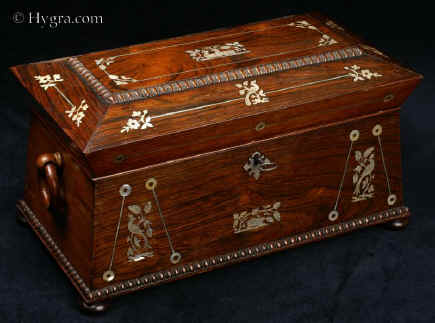
|
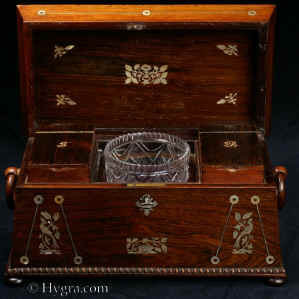
|
This particular piece is distinctive in that its inlaid decoration is
very deliberately used to create a structural architectural
effect. This tea chest is actually structured to be redolent of a
temple. The symmetrical mother of pearl inlay on each side of the front,
tapers inwards, as if one is looking at a temple entrance and the
perspective makes the top of the pillars look smaller. The inlaid lines
reinforce the impression of the perpendicular diminution in width. The
whole box tapers inwards and then it is crowned by what looks like an
angularly constructed roof. The design is the result of a sophisticated
and well informed mind, able to transfer the rules of one discipline to
another, without resorting to inappropriate slavish copying.
|
Please click on images to enlarge or |
slide show |thumbnail index |
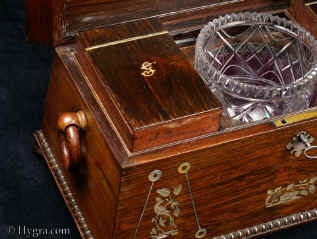
|
The
shape of this tea chest combines elements and influences characteristic
of the nineteenth century. It is
structured in an architectural form combining tapered
and pyramid lines which make this caddy a strong statement of the
robust and elegant style of the late Regency and early Victorian. The
fine inlays which depict stylized flora and fauna are in mother of pearl
and contrast with the dark highly figured rosewood. The central
compartment has the original heavy hand blown and cut crystal mixing
bowl. The bowl sits in a specially made recess, which is faced with mitered
and book matched rosewood The
drop handles are turned from solid rosewood. The inlaid escutcheon is in
Mother of pearl.
The
main body of the caddy sits on a base which is edged in gadrooned
rosewood. The top part is also gadrooned. These decorative edgings
were made on a lathe and attached to the box. Circa
1835-40
|
The tops canisters are inlaid with a "G" and a
"B", which stand for green and bohea or black tea.
Chinese tea was basically divided between green tea and black
tea See: www.gol27.com/HistoryTeaBotanics.html
The original purpose of the bowl was for sugar and not as sometimes
stated today mixing the tea.
|
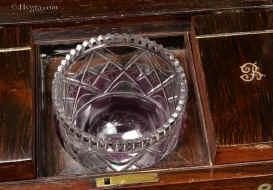
|
Please click on images to enlarge
The bowl sits in a central well. The framing is in
bookmatched rosewood. The well is lined velvet
which is Tyrian Purple.
See:
hygra.com/uk/wb2/wb136/index.htm#02
It was one of the most
fashionable colors in the Victorian period. A synthetic dye was not
developed until the begining of the 20th c.
|
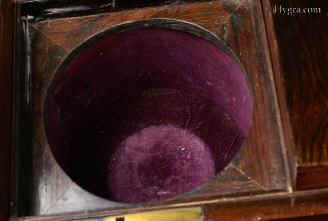
|

|
The lift out canisters retain some of their original leading
|
Please click on images to enlarge or |
slide show |thumbnail index |
The cut crystal bowl is also
exceptional. It has curves and straight hobnail cuts. It is probably
Irish and and is much the same date as the chest.
The tax on
the weight of materials used in glass manufacturing in England and
Scotland did not apply in Ireland until 1825.
This resulted
in the setting up of glassworks in various port towns in Ireland such as
Waterford and Cork (1783)
|
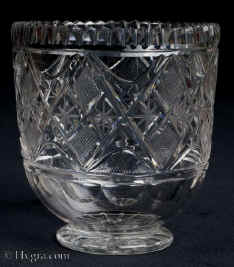
|
Please click on images to enlarge or |
slide show |thumbnail index |

|
A
|
This tea chest is actually structured to be redolent of a
temple. The symmetrical mother of pearl inlay on each side of the front,
tapers inwards, as if one is looking at a temple entrance and the
perspective makes the top of the pillars look smaller. The inlaid lines
reinforce the impression of the perpendicular diminution in width. The
whole box tapers inwards and then it is crowned by what looks like an
angularly constructed roof. The design is the result of a sophisticated
and well informed mind, able to transfer the rules of one discipline to
another, without resorting to inappropriate slavish copying.
|

|
Please click on images to enlarge or |
slide show |thumbnail index |
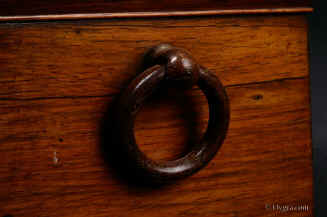
|
Detail showing the drop ring handle. These are fragile(!) it is not a
good idea to use them to actually carry or lift the box.
|
Please click on images to enlarge
Please click on images to enlarge or |
slide show |thumbnail index |
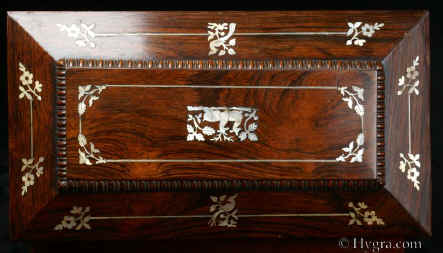
|
The top is beautifully orchestrated
with a central inlaid panel of figured rosewood framed by
gadrooning.
Gadrooning is made from solid
rosewood.
|
Please click on images to enlarge or |
slide show |thumbnail index |
Please click on images to enlarge
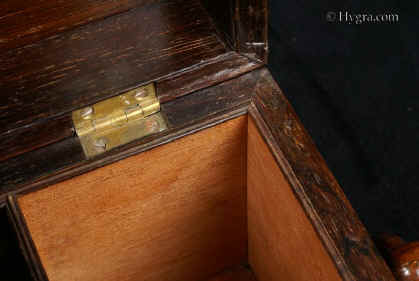
|
The structure of this type of chest is very complex. both
the lid and body are lined.
|
Please click on images to enlarge or |
slide show |thumbnail index |
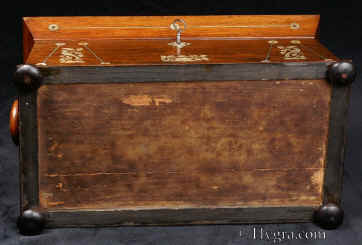
|
The underside of the chest is framed by a facing of
mitered rosewood. The paper covering looks original |
Please click on images to enlarge
Please click on images to enlarge or |
slide show |thumbnail index |Please click on images to enlarge or |
slide show |thumbnail index |
All text and images and linked images are ©
1999-2009 Antigone Clarke and Joseph O'Kelly. If you require any further
information on permitted use, or a licence to republish any material, email us
at copyright@hygra.com
|